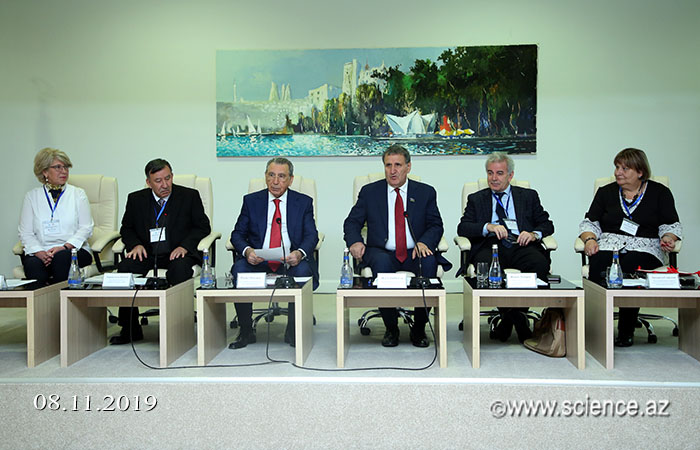- A-
- A
- A+
ANAS hosts "Rock Art: myths, painting and the world" international scientific conference

ANAS Central Scientific Library hosts an international scientific seminar on “Rock Art: myths, painting and the world” on November 8.
First of all, the guests got acquainted with the exhibition of works by ANAS employees, organized in the lobby of the library.
Opening the international seminar, ANAS President, academician Ramiz Mehdiyev welcomed the guests and noted that, the event was devoted to a very relevant topic. Academician emphasized that, earlier, with the support of the Fund for Humanitarian Cooperation of the CIS Member States, ANAS held international scientific conferences on various topics, carried out important measures aimed at restoring the traditions of scientific cooperation between countries. Speaking about the discussion of a very relevant and contemporary problem at last year’s international scientific conference, ANAS head said that, the events organized as part of the “Physics and Lyrics” conference at ANAS Shamakhi Astrophysical Observatory and the Joint Institute for Nuclear Research in Dubna (Russia) are important from the point of view of the formation of relationships between scientists engaged in the humanitarian field and representatives of the exact and natural sciences.
The speaker noted that, at the international scientific seminar on “Rock Art: myths, painting and the world” will be discusse serious scientific problems such as the formation of ancient civilizations, settlements of primitive people, the emergence of artistic thinking, written culture, etc. He stressed that, since today the issues of civilization and the resettlement of people are topical issues widely discussed at the international scientific community, the theses which will be announced today, will make a significant contribution to the development of world science..
At the end of his speech, ANAS President wished success in the work of the international scientific seminar.
Then, ANAS vice-president, academician Isa Habibbayli spoke that, in world science rock culture is perceived as a memory of the knowledge of primitive people carved on stone, rock paintings are one of the main factors that allow us to judge the origin and antiquity of an ethnos.
Noting that, "Rock culture of Azerbaijan reflects a sedentary culture, as well as legends and realities" the academician emphasized that, the images on the rock carvings of Azerbaijan cart, bull, yalla dance, tools and traction means indicate the development of sedentary culture in the region.
Isa Habibbayli said that, the famous cave paintings in Gobustan, located 40 kilometers from Baku are a stone chronicle of the life and work of our ancestors who lived on these lands. He added that, petroglyphs are the “caravan route of the history of the development of mankind”.
ANAS vice-president emphasized that, the holding of an international seminar is a correct and significant step aimed at coordinating the activities of scientists studying cave cultures.
Next, vice-president of the Academy of Sciences of the Republic of Tajikistan, academician Karamotullo Olimov, delivered a paper on "Philosophical-existential aspects of rock culture". The scientist noted that, along with aesthetic value, cave paintings contain deep philosophical evidence of the worldview of primitive people.
Stressing that, the event was devoted to an important topic, the speaker expressed his confidence that the regular holding of such events would make a significant contribution to the study of cave culture.
Director of the Institute of History and International Relations of Kemerovo State University, Doctor of Historical Sciences, Professor Olga Sovetova delivered a paper on "The world of unrealistic images in rock art of the Minusinsk depression”.
Noting the relevance of the topics discussed at the event, O.Sovetova praised the attention paid to the study of cave culture in Azerbaijan. She also talked about new methods used in the study of rock culture in the laboratory.
Rector of the Rostov Institute of Management, Business and Law, Doctor of Economy, Professor Imran Akparov spoke on the opportunities that digital and information technologies provide in the study of cave culture.
The workshop was also attended by the head of the Department of History and Cultural Studies of the Kyrgyz-Russian Slavic University Lyudmila Stavskaya, who presented a book on rock art in Kyrgyzstan.
Also at the event, reports were delivered on : “Rock art and modernity: historical and cultural reflection and ethnographic convergence”, “The Gamigai Monument Complex: a unique pearl of the South Caucasus”, “Analogs images of Gamigaya in the material culture of the Middle East ”, etc.
The international seminar continued its work in three sessions covering the themes: “Rock culture: traces of history and drawings”, “Rock culture: plots and pictograms” and “Rock culture: world experience and realities of Azerbaijan”. Along with domestic scientists, scientists and specialists from Russia, Kazakhstan, Moldova, Kyrgyzstan, Tajikistan, etc. delivered a scientific reports at the sessions.
The seminar will continue its work on November 9 in the Gobustan National Historical and Artistic Reserve.
©All rights are re served. Citing to www.science.gov.az is necessary upon using news.

 Elm TV
Elm TV
 Photo
Photo
 Video
Video



